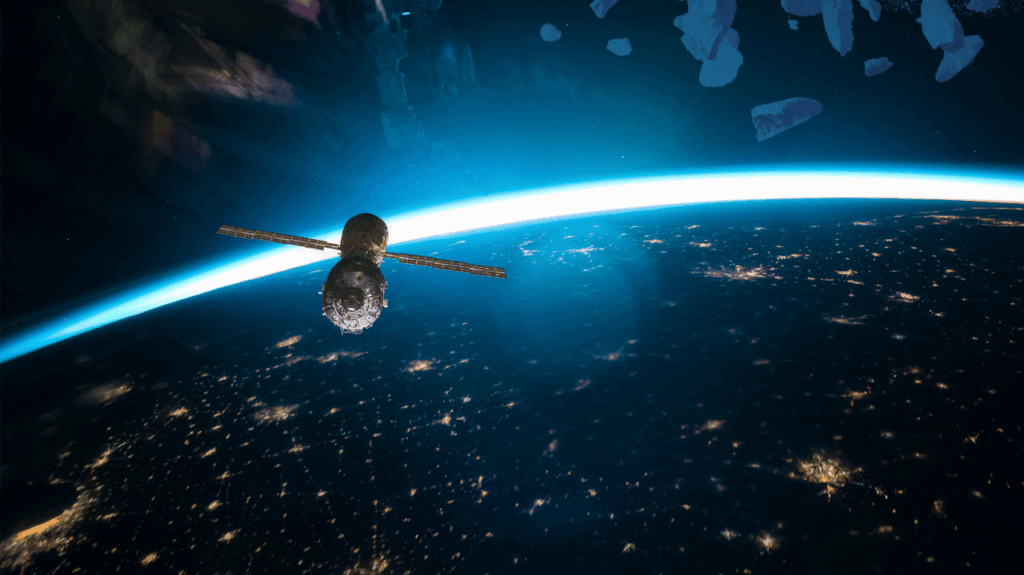There’s a rather urgent issue regarding space, and it’s neither Martian tourism nor the next lunar mission. Instead, it concerns traffic around Earth, which in recent years has become busier than some highways during rush hour.
Currently, according to the European Space Agency (ESA), more than 13,500 satellites orbit Earth, about 11,000 of which are operational. Alongside these are an alarming amount of space debris—over a million fragments larger than one centimeter—produced by collisions and decommissioned satellites, turning low Earth orbits into a veritable space junkyard.
New space debris: how to deal with the issue
In 2009, the collision between the active satellite Iridium 33 and the decommissioned Russian satellite Cosmos 2251 created thousands of new debris fragments. This incident is one of the most famous examples of the real, rather than theoretical, dangers of orbital congestion.
To tackle this problem, there is considerable discussion about Space Traffic Management (STM), a system aimed at intelligently managing satellite orbits by predicting collisions and planning timely maneuvers. However, the technological heart of this intelligent management lies in the satellites’ own ability to move with agility and precision—a feature directly dependent on their propulsion systems.
The role of advanced and sustainable propulsion systems
Advanced propulsion has indeed become key to the safety of space operations. Satellites must be able to quickly alter their orbits to avoid collisions or hazardous debris. Traditional systems based on fuels such as hydrazine or noble gases like xenon pose safety risks and are also environmentally and economically unsustainable.
For this reason, the space industry is developing new propulsion technologies. In 2021 ESA stated: “Thrust produced with water-electrolysis systems can be up to 14 times higher than an electrical propulsion system at the same power input”. Faster maneuvers significantly reduce operational risks, during satellite repositioning, collision avoidance, de-orbiting, etc. and permit additional revenues over 40M€/satellite, due to its extended operability
The water electrolysis solution
The use of water, which is extremely cheap, not hazardous, not pollutant, does not require suppliers from non-EU countries, ensures sustainability and simplifies in-space refuelling, reduces operational risks, by eliminating high-pressure tanks, the relative leakage and increases system reliability. Moreover, the water-electrolysis technology, requiring a lower amount of electrical input power, compared to the Electrical Propulsion systems, needs fewer components contributing to a simpler system architecture and then to the reduction of space debris and the preservation of valuable orbital slots. All those benefits make the water-electrolysis propulsion technology one of the best solutions for “cost-efficient propulsion for in-space mobility of spacecraft”.
A fundamental advantage of this technology is the high operational autonomy, crucial in an increasingly congested and unpredictable environment. Satellites equipped with advanced thrusters can perform corrective maneuvers in very short periods, quickly responding to collision alerts issued by control agencies.
Regulations and Agreements to speed up the process
Naturally, advanced propulsion alone is not enough: clear and shared regulations are also necessary. The European Union is working to harmonize international regulations, promoting the sharing of orbital data to prevent accidents. Organizations like the Space Data Association play an important role in this regard, creating integrated platforms for data exchange to provide more precise and timely predictive analyses, essential for rapid decision-making.
Simultaneously, active efforts are underway to remove existing space debris. Initiatives such as ESA’s ClearSpace-1 mission, scheduled for 2026, exemplify these efforts. Its task will be to capture non-operational satellites and remove them from orbit. ESA itself has also proposed a simple but effective rule: imposing a maximum orbital lifetime of 25 years for decommissioned satellites. Universally adopting this regulation could substantially reduce debris.
However, the proliferation of large private satellite constellations, like Starlink, increasingly necessitates updating rules and operational practices to integrate these new propulsion technologies.
In short, effective management of space traffic inevitably requires an intelligent combination of advanced propulsion, updated regulations, and international cooperation, thereby preventing the space surrounding Earth from permanently becoming a chaotic orbital junkyard.

